Published:
Author: Antonio Maria Guerra
Potato Chips
Some types of food are so much part of our everyday life to attract little attention. Great is the surprise finding out their true origin, involving fascinating stories and interesting people. People like George Crum, a very special cook, considered by many the ‘accidental’ inventor of the most famous snack in the world: potato chips, also known as ‘crisps’.

The origins of potato chips: the legends.
Many believe that the invention of potato chips happened by chance. There are many legends about it, the most frequently mentioned are two, both of them involving a colored cook, George Crum, and his sister, Catherine ‘Aunt Katie’ Wicks.

A fussy customer.
The most popular legend tells that chips were invented thanks to a fussy customer: he kept insisting that the fries he was served were too thick. After many attempts to please him, the cook, George Crum, cut the potatoes so thin that, once fried, they became crisp.

A clumsy cook.
Another legend says that ‘Aunt Katie’, slicing a potato, cut a very thin piece by mistake and this accidentally fell in a pan, starting to fry. As fate would have it, his brother George Crum tasted this fragment and was immediately amazed by its taste and crispness.
Saratoga Spings: the birthplace of potato chips.
Potato chips were invented, perhaps by chance, near Saratoga Springs, a charming county in the US State of New York.


The true history of potato chips.
As already said, the two stories mentioned in the previous paragraph, although quite famous, are just legends, since there is no evidence to prove them. Colorful anecdotes, possibly created by some newspapers to attribute the origins of potato chips to Saratoga Springs. It’s important to remember that George Crum always kept a very low profile about these stories, letting them spread but avoiding any comment, at least officially. So, it’s no coincidence that he never patented his invention.
Read more
People very likely enjoyed chips well before it’s commonly believed. For example, very similar recipes can be found in at least a couple of cookbooks dating back to early Nineteenth Century. Digging further into the past, comes out that their origins should be probably attributed to one of the European countries, like Spain, France, Germany and the Netherlands, where potatoes have been cooked and eaten for centuries.
The undeniable merit of George Crum and of all those who sold potato chips in Saratoga Springs, was to transform this simple food into a true cultural phenomenon, making it famous worldwide.

Potato Chips: the song.
1956, the American jazz singer Bulee “Slim” Gaillard dedicates a song to one of the most famous appetizers in the world: the name of the song is ‘Potato Chips’.

George Crum: the supposed inventor of potato chips.
eorge Crum was born in 1824 in Saratoga County (State of New York). It is known for certain that his mother was a Native American, but there are still doubts about the father: some say that he was of European origin, some others African.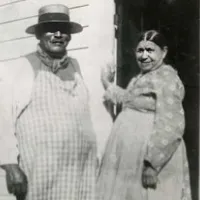 George began to make a living as a guide and as a hunter, supplying local restaurants with game and fish. One of his most important customers was the famous Hotel San Souci, where some years later he started to cook as an apprentice. In 1854 he worked with his sister ‘Aunt Katie’ at the Moon’s Lake House: it is said that this is the place where he invented potato chips. In 1860 he opened in Storey Hill (near Malta, NY) his restaurant: the ‘Crum’s’. Its customers included some of the most important people of the time.
George began to make a living as a guide and as a hunter, supplying local restaurants with game and fish. One of his most important customers was the famous Hotel San Souci, where some years later he started to cook as an apprentice. In 1854 he worked with his sister ‘Aunt Katie’ at the Moon’s Lake House: it is said that this is the place where he invented potato chips. In 1860 he opened in Storey Hill (near Malta, NY) his restaurant: the ‘Crum’s’. Its customers included some of the most important people of the time.

George Crum or George Speck?
George Crum quite often signed official documents as ‘Speck’: was this his original surname? It’s quite difficult to say since he was part Native American and part African.
There are many hypotheses, here follows a couple of them:
- Some people think that his real surname was ‘Speck’ and that he started to use ‘Crum’, the nickname given to his father when he was a jockey.
- Some other people claim that ‘Crum’ is a nickname he got from one of his best customers: Cornelius Vanderbilt.

The restaurants of George Crum.
Three places have great importance in the life of George Crum:
1) The Hotel San Souci, one of the most important in Saratoga Springs during the Nineteenth Century. He started supplying its restaurant with fish and game and then worked in its kitchens as an apprentice cook.
2) The Moon’s Lake House, where he worked as a cook. Legend says that here he invented the potato chips.
3) The Crum’s: his own restaurant, founded in 1860.
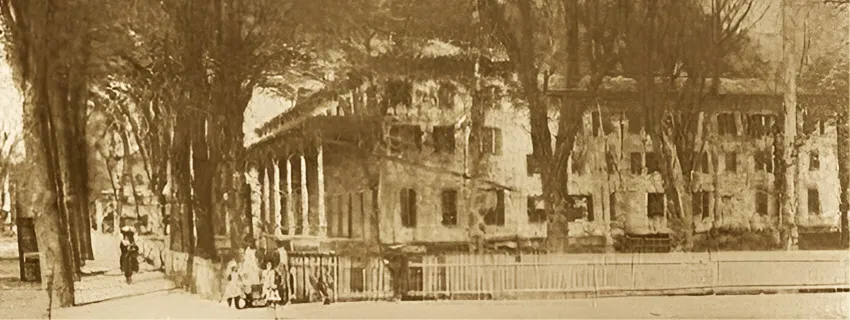
The Hotel San Souci.
Since its construction, completed in 1803, and for many years after, the San Souci was the most important hotel in Ballston Spa, a city not far from Saratoga Springs. Its structure was built with the specific intent of accommodating the rich people visiting the area for its renown mineral springs. It was provided with a great number of elegantly furnished rooms, lavish halls, a luxury restaurant and a billiard room. All these services were quite expensive: one day at the San Souci could cost more than an entire week in a good hotel.
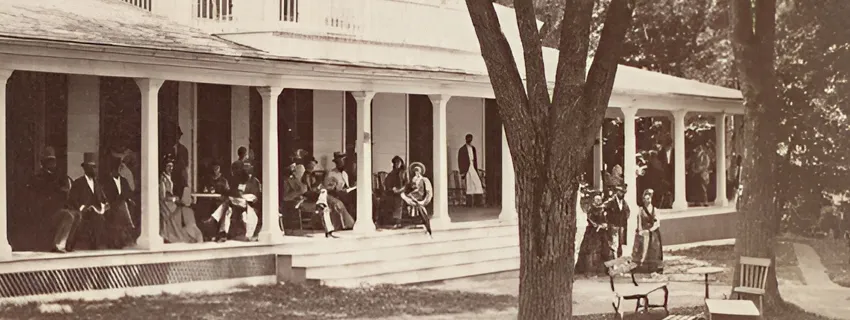
The Moon’s Lake House.
It was the year 1853 when Cary Moon and his wife Harriet bought the Loomi’s Lake House and gave it their name: the Moon’s Lake House was born. Although the competition from the other lake houses was fierce, they were strongly determined to beat it, doing things in style and offering many entertainment options to their rich customers. The gossip about their exclusive private parties spread very fast: these events, attended by the most famous and influential people of the time, became the forbidden dream of every American.
The ‘Crum’s’ in Storey Hill.
In 1860 George Crum, after a lifetime of hard work, opened his restaurant: the ‘Crum’s’. Since the beginning, its menu offered delicious and top quality food and attracted a lot of wealthy and influential people. Among them, great tycoons like Cornelius Venderbilt and Jay Gould. It is said that baskets full of the famous potato chips decorated the tables of this restaurant.
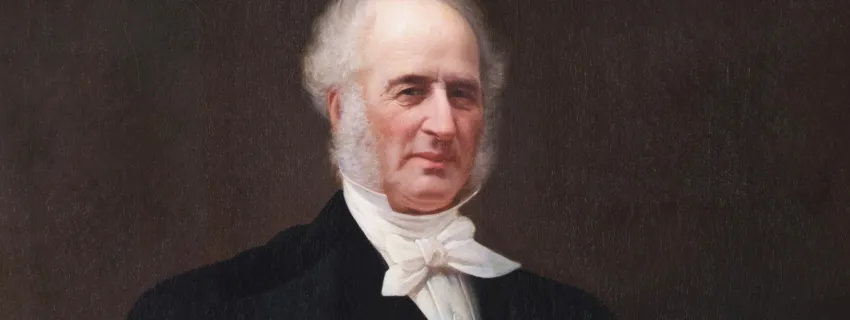
Vanderbilt, Crum and potato chips.
Cornelius Vanderbilt, one of the richest men of all time, enjoyed so much the food prepared by Goerge Crum, to become one of his most loyal clients. Some even speculate that he could be the fussy customer who accidentally led to the invention of potato chips.
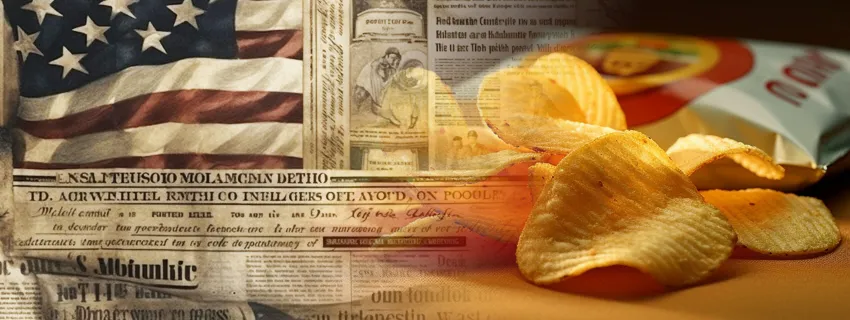
Many names for potato chips.
In the United States, crispy potatoes were initially known as ‘Saratoga fried potatoes’ or ‘Saratoga chips’. Some called them ‘potato crunches’. Today the name most commonly used is ‘potato chips’ or just ‘chips’.


The ‘Lake Houses’.
The ‘lake houses’ were places of entertainment for the people visiting Saratoga Springs. These entertainments included, for example, panoramic excursions and the opportunity to rent a boat to visit the lake or to go fishing.
Read more
Generally, it was not possible to rent a room. Restaurant service was often available: waiting for the meal, guests could chill out, drinking an aperitif and eating the renowned ‘Saratoga Chips’.
Some houses, like the Moon’s Lake House, were very famous for their exclusive parties: these events, celebrated by many gossip magazines, often lasted all night.

An aperitif at Moon’s.
The guests of the Moon’s Lake House could relax themselves sitting in its large patio and drinking a delicious aperitif accompanied by the famous chips while enjoying a spectacular view of the lake.

Potato chips 'invade' the United States.
The great success and the diffusion of potato chips throughout the United States is due to a brilliant nurse and a salesman. The nurse invented the right packaging to preserve their crispness, the salesman was the best to produce and distribute them all around the country.

Laura Scudder
Laura Scudder started her working career as a nurse. Some years later, in 1926, she left this job and founded a food and snack company. She is particularly famous for a brilliant idea she had: to put potato chips in waxed paper bags, to keep them fresh and crisp for a long time. An extremely important innovation, since it allowed their large scale production.

Herman Lay
After having lost his first job in 1929, during the Great Depression, Herman Lay started to work as a commercial agent, selling packets of chips throughout the United States. In 1932, thanks to a small loan, he founded his own snack company, the H.W. Lay Distributing Company: this soon became the most important in the country. Nowadays, Frito Lay is a subsidiary of PepsiCo Inc.

The right beverage for potato chips.
What to drink with some crispy potato chips? A good choice could be a beer, soft, medium warm and quite fresh.
- Its softness balances the saltiness of potato chips.
- Its alcohol balances the (induced) succulence of the potatoes and the greasiness of the frying.
- The acidity balances the sweet tendency of the potatoes.

Copyright information.
The images displayed in this page belong to WebFoodCulture, with the exception of:
Public domain images:
- George Crum, 1900 circa, Georgs S. Bolster Collection. (Wikipedia Link) {PD-US}
- Sans Souci Hotel in Ballston Spa, NY in 1887 (Wikipedia Link) {PD-US}
- Moon’s Lake House, Saratoga Springs, NY, 1896 (Wikipedia Link) {PD-US}
- Cornelius Vanderbilt, Newport Mansions, 1877 (Wikipedia Link) {PD-US}
